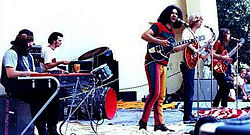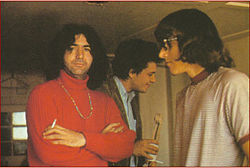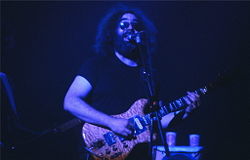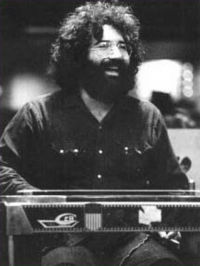Jerry Garcia
| Jerry Garcia | |
|---|---|
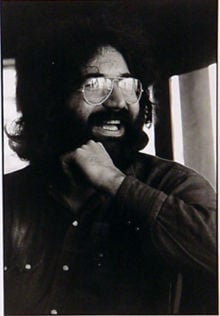 | |
| Background information | |
| Birth name | Jerome John Garcia |
| Born | August 1, 1942 |
| Origin | San Francisco, California, USA |
| Died | August 9 1995 (aged 53) Forest Knolls, California, USA |
| Genre(s) | Folk rock, jam band, bluegrass, soul music, country rock, rock and roll, psychedelic rock, rhythm and blues |
| Occupation(s) | Artist, musician, songwriter |
| Instrument(s) | Piano, banjo, electric guitar, pedal steel guitar |
| Years active | 1960 – 1995 |
| Label(s) | Rhino, Arista, Warner Bros., Acoustic Disc, Grateful Dead |
| Associated acts | Grateful Dead, Legion of Mary, Reconstruction, Jerry Garcia Band, Old and in the Way, Jerry Garcia Acoustic Band, New Riders of the Purple Sage |
| Website | JerryGarcia.com |
| Notable instrument(s) | |
| Gibson SGs Guild Starfire 1957 Gibson Les Paul Gold-top Les Paul with P-90 Fender Stratocaster "Alligator" Doug Irwin-modified Alembic "Wolf" Doug Irwin Custom "Tiger" Doug Irwin Custom "Rosebud" Stephen Cripe Custom "Lightning Bolt" | |
Jerome John "Jerry" Garcia (August 1, 1942 – August 9, 1995) was an accomplished artist, author, multi-talented musician, and the lead guitarist and vocalist for the rock and roll band Grateful Dead. The band amplified not only music and Garcia’s eclectic musicianship, but also his tendency to good cheer and general goodwill, his intelligence, willingness to speak his mind, and libertarian attitude. He was an exemplar of the communitarian, drug-positive hippie sub-culture of San Francisco’s Haight-Ashbury district. The district served as a destination for millions of youthful seekers from across the modern world during the mid 1960s. The Grateful Dead’s thirty-year career was a cultural phenomenon, an enduring symbol of something called "peace and love." News of his death merited a front-page article in the New York Times. United States President Bill Clinton, who enjoyed giving neckties designed from Garcia's artwork as gifts, called him "an American icon."
Early years
Garcia’s father Jose Ramon "Joe" Garcia emigrated with his family in 1919 from the Galicia region of northwest Spain to San Francisco; his mother was of Irish and Swedish lineage whose family had been in San Francisco since the mid-nineteenth century. Garcia, named by his musician father after Broadway musical composer Jerome Kern, was born and raised in San Francisco and its environs. Traumatically, he witnessed the drowning death of his father in 1947 when he was 5 years old. His mother, equally traumatized by the event and unable to care for her two sons adequately, assumed management of the bar that his father had established. Young Jerry and his older brother Clifford went to live nearby with their maternal grandparents.
Garcia and his brother grew up in the care of their maternal grandparents, Bill and Tillie Clifford, at 87 Harrington Street in the Excelsior District of San Francisco. Tillie Olsen Clifford was an enormously popular woman. She was the secretary treasurer for the local Laundry Workers Union of the American Federation of Labor. It was an elected post which she won time after time until her retirement. Her father (Garcia's great–grandfather), known today only as Captain Olsen, was a merchant sea captain from Sweden. Captain Olsen, like many others, abandoned the sea and his ship in San Francisco Bay for the gold rush of 1849 at Sutter's Mill northwest of San Francisco on the Russian River.[1]
Despite the accidental amputation of his middle right finger just below the first knuckle at nine years old by his older brother Clifford (Tiff) Garcia during a family camping trip, Garcia taught himself the banjo and piano, moved on to the guitar, and eventually mastered many stringed instruments.
During his childhood Garcia was influenced by his teachers, who were sometimes self-selected, to appreciate art, Bohemian exuberance, and as he put it, "the intellectual world." He attended Balboa High School in the Mission district of San Francisco. When he was fifteen years old, he joined a gang as a way to cope in a rough and tumble high school. At age 17, in 1959, Garcia dropped out of high school. He was passionate about music and all the formats that were available to him; folk, blues, rock, bluegrass and developed an interest in marijuana. After he left high school, Garcia enlisted in the United States Army the next spring, on April 12, 1960. He eventually was stationed at San Francisco’s Presidio. He was discharged on December 14, 1960 as unadaptable to life in the Army, following eight Absences Without Leave (AWOL), leading to two court martials.
Fledgling Musical Efforts
After his discharge from the U.S. Army, Garcia, David Nelson, who went on to form New Riders of the Purple Sage in 1969, and a poet named Robert Hunter teamed up to make music, calling themselves The Zodiacs. Years later, Hunter would become the premier lyricist for Grateful Dead. During this period, Garcia worked in a music store in Palo Alto teaching acoustic guitar and banjo. Until 1964 he worked small venues, performing mainly bluegrass, old-timey music, and folk music. His musical circle included Nick Gravenites, Pete Stampfel, Jorma Kaukonen, Jack Cassady, Janis Joplin, Grace Slick, Paul Kantner, and David Freiberg. They lived on the fringe of the Stanford University youth culture, sustained by the largess of students and their well-to-do parents.
Along with lifelong musician friend David Grisman Garcia traveled the American countryside in the early 1960s, searching for their own ideal in the the high lonesome sound of bluegrass and country music. According to Caroline Garcia, Garcia's wife and longtime companion, the two found their inspiration in the group The Kentucky Colonels an adapted the sound in their own musical efforts, most notably Old and in the Way. Django Reinhart, one of the first prominent European jazz musicians, also provided inspiration. Reinhart had suffered injury to his left hand causing the loss of his third and fourth fingers yet continued as a guitar virtuoso. Having lost the middle finger on his right hand, Garcia looked to Reinhart to overcome his own disability.
With his friend, fellow high school drop out, and blues singer, musician Ron "Pigpen" McKernan, Garcia formed Mother McCree’s Uptown Jug Champions in 1964 along with Bob Weir, a then sixteen year old guitarist whom Garcia met the previous New Year's Eve.[2] Weir and another underage friend had been wandering the back streets of Palo Alto looking for a club that would admit them, when upon hearing banjo music, stumbled upon Dana Morgan's Music Store. Garcia, oblivious as to the date, was waiting for his student to arrive for a lesson. Weir and Garcia spent that New Years Eve night playing music together. Until Garcia's death in 1995, they continued this tradition annually for thousands of deadheads in San Francisco at various venues and later across the bay in Oakland at the Oakland Colosseum.
Over the course of its existence, Mother McCree's Uptown Champions featured a number of different musicians. In 1965, at Pigpen's urging, Mother McCree's became an electric band, adopting a mix of blues and rock and roll and changed their name to The Warlocks. The line up included Garcia on lead guitar, Weir on rhythm guitar, McKernan on electric piano, Dana Morgan junior on bass and Bill Kreutzman on drums. During the band's early days, Kreutzmann sometimes used a fake draft card with the name "Bill Sommers" to be admitted to bars where the band was playing, since he was underage.[3] Garcia later said,
It was Pigpen’s idea; he wanted me to start up an electric blues band. And all of a sudden there were The Beatles, and that, wow, the Beatles, you know. Hard Day’s Night, the movie and everything. We thought, great, that really looks like fun. Theoretically it (Mother McCree's Uptown Jug Champions) was a blues band, but the minute we got electric instruments it was a rock and roll band.
The band picked up a local following that attracted an acquaintance, classically trained musician Phil Lesh, to come from Berkeley to listen. Lesh was the last member to join the Warlocks before they became the Grateful Dead, he replaced Dana Morgan Jr. who had played bass for a few gigs. Lesh never played electric bass before he took Dana Morgan's place. Later that year (1965) they adopted the name, Grateful Dead. The name, Garcia said, popped out when he opened an Oxford Dictionary at Phil Lesh’s house. Another account has that it came out of the Egyptian Book of the Dead which Garcia was perusing at a public library: "We the grateful dead salute you, O Osiris."
The Acid Tests
The group lived for a time near Ken Kesey, founder of the Merry Pranksters, in Palo Alto. Relationships developed between the two groups. In 1963 Robert Hunter and Kesey had participated in government testing of mescaline and psilocybin and LSD at Stanford University, and by 1964 they were able to obtain the drugs for their like-minded friends on the San Francisco peninsula, in San Francisco, in Berkeley, and in Marin County. The following is edited from a Rolling Stone magazine interview with Garcia, conducted by Charles Reich and Jan Wenner in 1971.
The drugs impacted their approach to music. Garcia later recalled, "It changed everything. It freed me… The first time that music and LSD interacted in a way that came to life for us as a band was one day when we went out and got extremely high and went that night to a concert by the Lovin’ Spoonful, the Charlatans and whoever else down at the Family Dog. It was just really fine to see that whole scene—there was just nobody there but heads and this strange rock & roll music playing in this weird building. It was just what we wanted to see. We began to see that vision of a truly fantastic thing. It became clear to us that playing in bars was not going to allow us to expand into this new idea. And about that time the Acid Test was just starting to happen."
The first Acid Test featured Garcia’s fledgling band, generous distribution of LSD to people taking it knowingly or unknowingly, strobe lights, filming and audio recording. "They had film and endless kind of weird tape recorder hookups and mystery speaker trips and all… just all sorts of really strange . . . it always seemed as though the equipment was able to respond in its own way. I mean it . . . there were always magical things happening. Voices coming out of things that weren’t plugged in and, God . . . it was just totally mind-boggling to wander around this maze of wires and stuff like that. Sometimes they were like writhing and squirming. That was the Acid Test, and the Acid Test was the prototype for our whole basic trip. But nothing has ever come up to the level of the way the Acid Test was. It’s just never been equaled, really. What happened was light shows and rock & roll came out of it, and that’s like the thing that we’ve seen go out [into the larger culture]."
The second Acid Test included Richard Alpert (a.k.a.Baba Ram Dass) and people from "the Berkeley psychedelic scene, which was pretty well developed by that time because of the Cabale coffeehouse in the old days, the mescaline scene and all that. Neal Cassady and Ann Murphy were there. Stewart Brand was there with his Indian stuff. He had this little slide show and recorded music, taped music, and he’d just show beautiful slides of Indian trips and Indian homes."
The Rise and Fall of the Hippie Culture
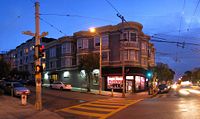
The band’s home shifted between the Haight-Ashbury and Marin County, depending on the patience of their landlords. In 1967, Jerry Garcia lived at 710 Ashbury Street, San Francisco, in the heart of the Haight Ashbury district.
"Our place got to be a center of energy and people were organizing activities. The Diggers, people trying to start spiritual movements, doing various benefits. There was a lot of motion, a lot of energy exchanged, and it was all very high in those days because at that time the Haight-Ashbury was a community. We had the Psychedelic Shop, the very first one, and that was news, and other people were starting to open stores and starting to get underway. Our whole scene [was] completely cooperative and entirely shared. We never structured our situation where anybody was getting any money. What we were doing was buying food, paying rent, stuff like that. That was our basic scene, and that’s basically how we still operate."
The band performed at the 1967 Human Be-In, which inaugurated the media-generated "Summer of Love." It was here that the musical and philosophical aspect of the youth culture of the 1960s crystallized in San Francisco and, within a short time, self-destructed. In Garcia’s words,
It was just about that same time that people started to come to town to find out about the hippie scene, and that’s about what the hippie scene was—it was just a very small neighborhood affair when we were all working for each other’s benefit. Most of the people of the Haight-Ashbury scene were people who had been at San Francisco State and gotten into drugs and acid and stuff like that and were living out there experimenting with all the new things that they’d discovered. It was a very high, healthy kind of thing. There were no hard drugs, only pot and LSD.
Then the big media flash came out. Time magazine guys came out and interviewed everybody and took photographs and made it news. The feedback from that killed the whole scene. We could no longer sustain the tiny trickle that was really supporting everybody. The whole theory in hip economics is essentially that you can have a small amount of money and move it around very fast and it would work out, but when you have thousands and thousands of people, it’s just too unwieldy. And all the attempts at free food and all that, certain people had to work too hard to justify it. At the early stages we were operating completely purely without anybody looking on, without anybody looking through the big window. We were going along really well. And then the crowds came in. All the people who were looking for something. The Hollywood people came. There was a whole new consciousness starting to happen and it was really working nice, but then the flood came and that was it.
Garcia had a reputation during that period as the spiritual adviser to the community. He refutes it and credits the image to reference to him as spiritual adviser centered on the back cover of second Jefferson Airplane album, Surrealistic Pillow. He credited himself with being a "compulsive question answerer, but that doesn’t necessarily mean I’m right or anything. That’s just one of the things I can do. It’s like having a trick memory. I can answer any question."
Music and Musicianship
The band’s first album, produced in 1966, was called The Grateful Dead, produced by Dave Hassinger who had engineered two Rolling Stones records that the band liked. It was "just simply what we were doing on-stage. Basically that. Just rock & roll. We were playing all the places that were trying to become the Fillmore or trying to become the Avalon, as well as the Fillmore and the Avalon. And there were places down in L. A. that were trying to get started and places in San Diego."
For the next couple of years they were "an experimental music group" but with their fifth album, Workingman’s Dead (1970), they felt "more like a good old band… That was really the result of hanging out with (David) Crosby and those guys … just because they could sit down in any situation and pick up an acoustic guitar and it’s instant music, these beautiful vocal harmonies… I think that nothing really communicates like the human voice. It is really the ultimate instrument. I used to think of myself as a guitar player, but hearing singing, and seeing it up close, has made me want to sing a lot. It’s real satisfying to sing." The Dead produced numerous records, reflecting working-class American cultural issues: romantic love, keeping a job, being down on one’s luck, breaking the law, staying out of jail, gambling, as well as reflections on life’s beauty and occasional transcendence.
Garcia’s mature guitar playing melded elements from the various kinds of music that had enthralled him. Echoes of "hillbilly" and bluegrass playing (such as Arthur Smith and Doc Watson) could be heard. But the "roots music" behind hillbilly and bluegrass had its influence, too, and melodic riffs from Celtic fiddle jigs can be distinguished. There was also early rock (like Lonnie Mack, James Burton and Chuck Berry), contemporary blues (such as Freddie King and Lowell Fulson), country & western (such as Bill Monroe, Roy Nichols and Don Rich), and jazz (like Charlie Christian) to be heard in Garcia’s style. Garcia’s pedal steel guitar playing and his standard electric guitar work were influenced by Tom Blumley, of Buck Owens’s Buckaroos.
Garcia’s playing had a number of so-called "signatures" and, in his work through the years with the Grateful Dead, one of these was lead lines making much use of rhythmic triplets (examples include the songs "Good Morning Little School Girl," "New Speedway Boogie," "Brokedown Palace," "Black Peter," "Deal," Loser," "China Cat Sunflower," "That’s It For The Other One," "U.S. Blues," "Sugaree," and "Don’t Ease Me In").
The Grateful Dead’s Music and Philosophy
Garcia nonetheless was adept at turning the phrase in describing the ecstatic drug-music experience: "It was music I loved. That’s what it meant; I mean it didn’t mean anything—it meant have a good time, it meant rock & roll. I like the music; that was the thing. It was the background music for the events of my life. My theme music. Them rock & roll songs—that’s what was happening."
The Acid Tests were a venue, or avenue, that transitioned the standard 3-minute rock song into a longer odyssey of sound: "Our trip with the Acid Test was to be able to play long and loud. We could play long and loud, as long and loud as we wanted and nobody would stop us." The signature of Grateful Dead concerts was performing with no play lists, lengthy improvisations resulting in continually re-inventing songs, and improvised segues.
"We were improvising cosmically, because being high, each note is like a whole universe. And each silence. And the quality of the sound and the degree of emotional… when you’re playing and you’re high on acid in these scenes it is like the most important thing in the world. To get really high is to forget yourself. And to forget yourself is to see everything else. And to see everything else is to become an understanding molecule in evolution, a conscious tool of the universe. And I think every human being should be a conscious tool of the universe.
Our consciousness concerning music is opening up more, so the music is having more dimensions. We find a certain kind of feeling or a certain kind of rhythm and the whole place is like a sea and it goes boom… boom… boom. It’s like magic and it’s like that something you discover on LSD and you discover that another kind of sound will create a whole other reality. We’re just playing what’s there, is what it finally comes down to, because we’re not in a position to be deciding.

When asked the source of his optimism, Garcia replied,
Music is a thing that has optimism built into it. Optimism is another way of saying space. Music has infinite space. You can go as far into music as you can fill millions of lifetimes. Music is an infinite cylinder, it’s open-ended, it’s space. The form of music has infinite space as a part of it, and that, in itself, means that its momentum is essentially in that open place.
The things we do depend so much upon the situation we’re in and upon a sort of a magic thing. We aren’t in such total control of our scene that we can say, ‘Tonight’s the night, it’s going to be magic tonight.’ We can only say we’re going to try it tonight. And whether it’s magic or not is something we can’t predict and nobody else can predict; and even when it’s over and done with, it’s one of those things where nobody’s really sure. It’s subtle and it’s elusive, but it’s real.
Another result of the Acid Tests was the integration of the performers and the audience. The Dead were the first rock band, to this writer’s knowledge, to wear street clothes while performing, breaking the barrier between stage and floor, and paradigmatic to generations of bands since. In Garcia’s words,
The unfortunate thing about the concert situation for us is the stage; and the audience has either a dance floor where they all sit down or seats where they all stand up. It’s too inflexible to allow something new to emerge.
We never formulated it, it just was what was happening. We were doing the Acid Test, which was our first exposure to formlessness. Formlessness and chaos lead to new forms and new order. Closer, probably, to what the real order is. When you break down the old orders and the old forms and leave them broken and shattered, you suddenly find yourself a new space with new form and new order which are more like the way it is. More like the flow. And we just found ourselves in that place. We never decided on it, we never thought it out. None of it. This is a thing that we’ve observed. We’ve watched what happens.
From 1965 until 1995, for thirty years, the Grateful Dead "watched what happened" as they toured almost constantly, developing a fan base known as deadheads, renowned for their intensity of devotion. Some fans dedicated their lives to the band, following the Grateful Dead from concert to concert, making a living by selling handmade goods, arts, and crafts. The group and its community also pioneered the provision of hundreds of their taped concerts for free downloading off the Internet.
I think of the Grateful Dead as being a crossroads or a pointer sign, and what we’re pointing to is that there’s a lot of universe available, that there’s a whole lot of experience available over here.
Jerry Garcia, Rolling Stone Magazine, 1991
Side projects
In addition to the Grateful Dead, Garcia had numerous side projects, the most notable being the Jerry Garcia Band. He was also involved with various acoustic projects such as Old and in the Way and other bluegrass bands, including collaborations with noted bluegrass mandolinist David Grisman (the documentary film Grateful Dawg chronicles the deep, long-term friendship between Garcia and Grisman). Other groups of which Garcia was a member at one time or another include the Black Mountain Boys, Legion of Mary, Reconstruction, and the Jerry Garcia Acoustic Band. Jerry Garcia was also an appreciative fan of jazz artists and improvisation: He played with jazz keyboardists Merle Saunders and Howard Wales for many years in various groups and jam sessions, and he appeared on saxophonist Ornette Coleman’s 1988 album, Virgin Beauty.
Throughout the early 1970s, Garcia, bassist Phil Lesh, drummer Mickey Hart, and David Crosby collaborated intermittently with MIT-educated composer and biologist Ned Lagin on several projects in the realm of early electronica; these include the album Seastones and L, an unfinished dance work.
Garcia also lent pedal-steel guitar playing in fellow-San Francisco musicians' New Riders of the Purple Sage from their initial dates in 1969 to October 1971, when increased commitments with the Dead forced him to opt out of the group. He appears as a band member on their self-titled debut album, released in 1971 and made several guest appearances on subsequent albums in addition to producing Home, Home On The Road, a 1974 live album by the band. He also contributed pedal steel guitar to the enduring hit "Teach Your Children" by Crosby, Stills, Nash, & Young, likely the most recognizable piece of music to feature the guitarist. Despite considering himself a novice on the pedal steel and having all but given up the instrument by 1973, he routinely ranked high in player polls. After a long lapse, he brought the instrument out and played it once again when Bob Dylan teamed up with the Grateful Dead for a summer stadium tour in 1987.
Having studied art at the San Francisco Art Institute, Garcia made a second career out of painting landscapes. A series of neckties based on those paintings has been quite lucrative. The popularity of the ties might be attributed to their wild patterns and bright colors. Even in 2005, ten years after Garcia’s death, new styles and designs continue to be sold at high-end men’s stores.
Garcia was inducted into the Rock and Roll Hall of Fame in 1994.
Marriage, Family and Death
Jerry Garcia had one brother, Clifford "Tiff" Garcia. During his life, he married three times, and had four daughters: His first wife, Sara Ruppenthal-Garcia, with whom he had a daughter, Heather; Carolyn "Mountain Girl" Adams-Garcia, a Merry Prankster from the Ken Kesey–Neal Cassady days, with whom he had daughters Anabelle and Theresa; and Deborah Koons-Garcia. Also, Jerry Garcia had a relationship with Manasha Matheson and had a fourth daughter with her, Keelin Garcia.
In August of 1995, following a Grateful Dead summer tour that many fans called the "Tour from Hell," Garcia attempted drug rehabilitation at the Betty Ford Clinic, but found the expectations there too strict. Garcia left the Betty Ford clinic and checked into Serenity Knolls drug rehabilitation center in Forest Knolls, California where he found conditions more suitable. Jerry Garcia died on August 9, 1995, from a heart attack exacerbated by sleep apnea. Garcia struggled with tobacco and drug addiction (most notably heroin and cocaine), sleep apnea, and a poor diet for much of his adult life. In his later years, weight control became another health issue for Garcia, his body mass sometimes soaring up to 300 pounds. Memorial services were held in Golden Gate Park on August 13, 1995. Along with the band members, his family and friends, thousands of fans were present, many singing and playing in drum circles.
Deborah Koons-Garcia and Bob Weir, just after dawn on April 4, 1996, spread half Garcia’s ashes on the Ganges River 155 miles north of New Delhi, India, the idea for which reportedly came to Weir in a dream. The other half of his ashes were spread over San Francisco Bay earlier in a public ceremony attended by everyone whom Deborah Koons allowed on the boat that took the party out into the bay. Some of Garcia's close friends and family were left on the shore, including Carolyn Adams, his second and longest lived wife.
Legacy
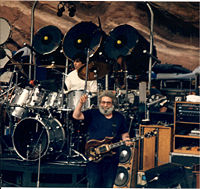
Rolling Stone named Garcia the 13th greatest guitarist of all time.[4]
In 1987, ice cream manufacturers Ben & Jerry's came out with Cherry Garcia, which is named after the guitarist and consists of "cherry ice cream with cherries and fudge flakes." It quickly became the most popular Ben & Jerry's flavor. For a month after Garcia's death, the ice cream was made with black cherries as a way of mourning.
On July 21, 2005, the San Francisco Recreation and Park Commission [5] passed a resolution to name the amphitheater in McLaren Park "The Jerry Garcia Amphitheater." The amphitheater is located in San Francisco's Excelsior District, where Garcia grew up. The first show to happen at the Jerry Garcia Amphitheater was Jerry Day 2005 on August 7, 2005. Tiff Garcia was the first person to welcome the audience to the "Jerry Garcia Amphitheater." Jerry Day is an annual celebration of Garcia in his childhood neighborhood. The dedication ceremony (Jerry Day 2) on October 29, 2005, was officiated by mayor Gavin Newsom.
On August 9, 2005, the late D12 member, rapper Proof, released his first solo-album, called "Searching for Jerry Garcia" in honor of the late Grateful Dead member. Upon the release, Proof said: "He played every kind of music—he had jazz albums, classical albums, he went against the grain," Proof said. "He didn't care about the record sales … I mean, his shows outsold his record sales. That almost don't make sense to me."
One of Garcia's legacies is the Jam band scene the Dead spawned. Phish, Umphrey's McGee and dozens of other groups not only play in the Dionysian spirit of the Dead, but keep the Deadhead spirit alive through shows that are, at their best, as much about community as they are about music.
On September 24, 2005, the "Comes a Time: A Celebration of the Music & Spirit of Jerry Garcia" tribute concert was held at the Hearst Greek Theatre in Berkeley, California. The Greek theater is an open air venue that hosted dozens of Jerry Garcia Band and Grateful Dead performances.[6] The concert featured Bob Weir, Bill Kreutzmann, Mickey Hart, Bruce Hornsby, Trey Anastasio (Phish), Warren Haynes (Government Mule), Jimmy Herring (Allman Brothers Band), Michael Kang, Jay Lane, Jeff Chimenti (Ratdog), Mark Karan, Robin Sylvester, Kenny Brooks (Ratdog), Gloria Jones, and Jackie LaBranch (Jerry Garcia Band). Two of Garcia's longtime band mates and friends, Phil Lesh and Robert Hunter did not attend. Hunter, overcome by grief, submitted an elegy written in the style of the Duino Elegies which he had studied years before in the late 1980s. Explaining his absence, Phil Lesh stated, "my son went away to college and we had all kinds of family things going that week." Later Lesh commented somewhat bitterly on CBS 60 minutes, "He loved the drug more than he loved the music, more than he loved us." This sentiment changed. During the 2010 Furthur tour which featured Lesh and Bob Weir supported by Jeff Chimenti of Ratdog, Joe Russo of the Benvenuto Russo Duo, and John Kadlecik of Dark Star Orchestra, Lesh's amplifier sported a lone sticker proclaiming, "I Miss Jerry."
The San Francisco Giants on Monday, August 9, 2010, joined Dead Heads everywhere as they paid homage to the 15th anniversary of Jerry's passing at AT&T Park. That night the Giants faced the Chicago Cubs. Garcia's last public appearance was in an arena setting in Chicago. All fans attending that night's game were treated to pre-game performances from Grateful Dead cover bands, a special home plate ceremony honoring San Francisco native and denizen Garcia, video tributes and other surprises.
Garcia’s ex-wives and band members struggled over his legacy, but those who knew him best remember Garcia fondly.
Notable quotes
- "They aren't exactly the best at what they do, they are the only ones who do what they do," overheard in a parking lot at a Grateful Dead venue.
- "The Grateful Dead are the last vestige of truly great improvisational rock and roll," overheard outside the Philadelphia Spectrum, March 1988.
- When I die, bury me deep. Put two speakers at my feet. Place the earphones on my head, and always play the Grateful Dead," Anonymous
- "Our fans are like people who like licorice. Not everyone likes licorice. But people who like licorice, like licorice a lot." Jerry Garcia, date unknown.
Discography
- Old and in the Way
- Old and in the Way (1975)
- That High Lonesome Sound (1996)
- Breakdown (1997)
- Garcia & Grisman
- Garcia Grisman
- Not for Kids Only
- Shady Grove
- So What
- The Pizza Tapes (featuring Tony Rice) (2000)
- Been All Around this World
- Grateful Dawg
- Solo
- Garcia (1972)
- Compliments (1974)
- Reflections (1976)
- Jerry Garcia Band
- Cats Under the Stars (1978)
- Run for the Roses (1982)
- Jerry Garcia Band (1991)
- How Sweet it is (1997)
- Don't Let Go (2001)
- Shining Star (2001)
- After Midnight: Kean College, 2/28/80 (2004)
- Legion of Mary
- The Jerry Garcia Collection, Vol 1: Legion of Mary (2005)
- Compilations
- Garcia Plays Dylan (2005)
- The Very Best of Jerry Garcia (2006)
- Jerry Garcia Acoustic Band
- Almost Acoustic (1988)
- Pure Jerry Series (2004-2005)
- Theatre 1839, July 29 & 30, 1977
- Lunt-Fontanne, NYC, October 31, 1987
- Lunt-Fontanne, NYC, "Best of the Rest"
- Keystone Berkeley, September 1, 1974
- Merriweather Post Pavilion, September 1 & 2, 1989
- Warner Theatre, March 18, 1978
Notes
- ↑ Jerome Garcia, Harrington Street(New York: Delacorte Press, 1995). ISBN 0385313535
- ↑ Sandy Troy, One More Saturday Night, (New York: St. Martin's Press, 1992). ISBN 0312077599
- ↑ "Pop Quiz—Q & A with the Dead's Bill Kreutzmann," San Francisco Chronicle, January 11, 1998
- ↑ Rolling Stone, 100 Greatest Guitarists of All Time.
- ↑ San Fransisco Gov, Parks and Recreation. Retrieved June 7, 2007.
- ↑ Rolling Stone, Trey, Weir Honor Garcia.
ReferencesISBN links support NWE through referral fees
- Dodd, David G. & Diana Spaulding. The Grateful Dead Reader. Oxford University Press: New York, 2000. ISBN 0-195-12470-7
- Greenfield, Robert. Dark Star: An Oral Biography of Jerry Garcia. W. Morrow: New York, 1996. ISBN 0-688-14782-8
- Reich, Charles & January Jan Wenner. 1972. "Interviews with the Dead", geocities.com, Rolling Stone Interviews. Retrieved January 24, 2007.
- Troy, Sandy, Captain Trips: a biography of Jerry Garcia. Thunder's Mouth Press: Publishers Group West, Emeryville, CA, 1994. ISBN 1-560-25076-3
External links
All links retrieved July 31, 2022.
- Big Brother & The Holding Company Site.
- Dead Lists home page.
- Garcia.
- Jerry Day.
- Dead.net.
- GDRADIO.NET - Streaming Grateful Dead and more.
- The Annotated Grateful Dead Lyrics.
- "Grateful Dawg" on IMDB.
- Over 2800 Grateful Dead recordings available in streaming format.
- Gratefuldeadbooks.com.
Credits
New World Encyclopedia writers and editors rewrote and completed the Wikipedia article in accordance with New World Encyclopedia standards. This article abides by terms of the Creative Commons CC-by-sa 3.0 License (CC-by-sa), which may be used and disseminated with proper attribution. Credit is due under the terms of this license that can reference both the New World Encyclopedia contributors and the selfless volunteer contributors of the Wikimedia Foundation. To cite this article click here for a list of acceptable citing formats.The history of earlier contributions by wikipedians is accessible to researchers here:
The history of this article since it was imported to New World Encyclopedia:
Note: Some restrictions may apply to use of individual images which are separately licensed.
